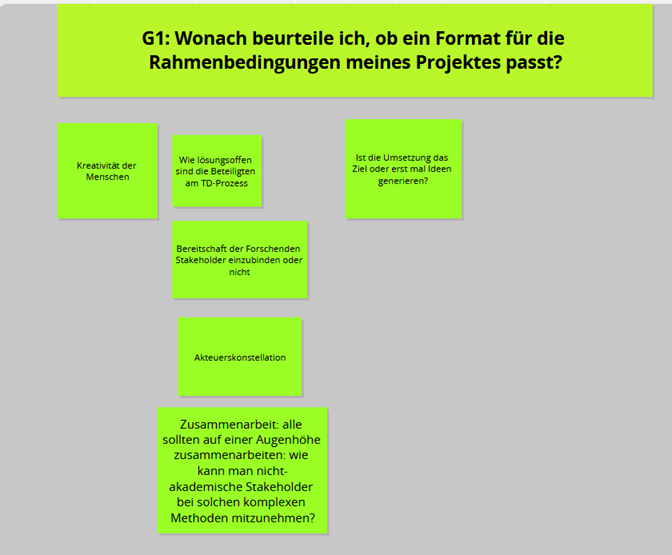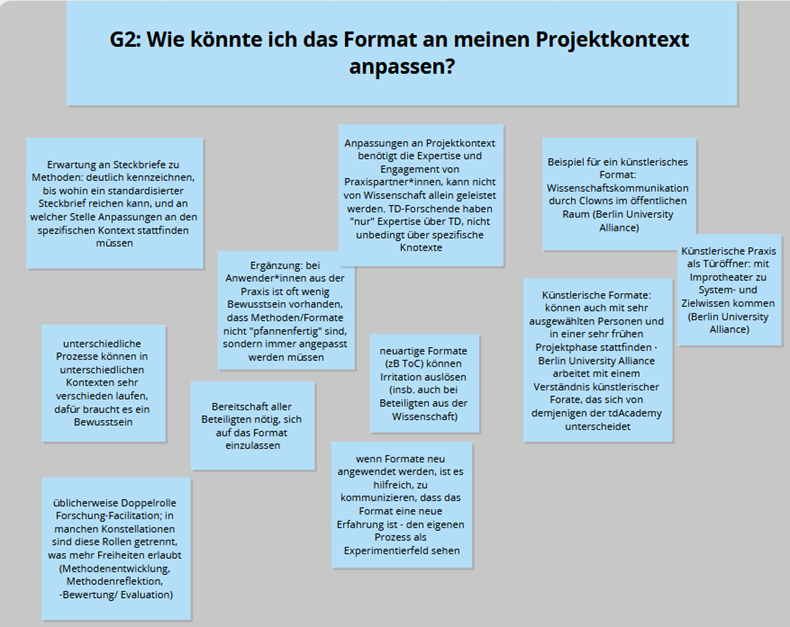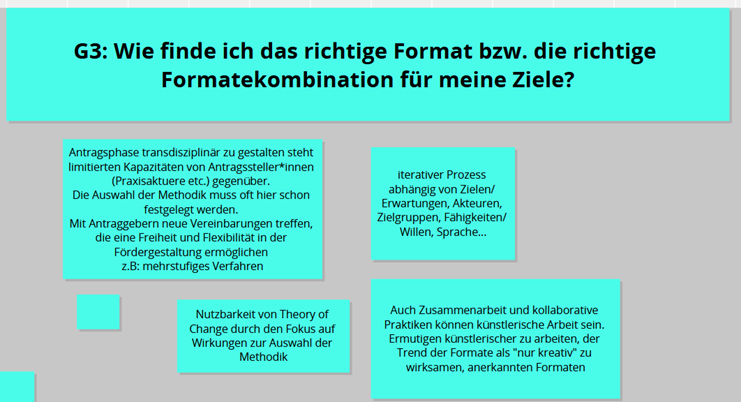On April 20, 2023, Melanie Mbah, Regina Rhodius and Bettina Brohmann (all Öko-Institut e.V.) organized a digital reflection workshop on topic line 4 "New Formats". In a two-hour workshop format, the findings on the characteristics of five innovative formats of transdisciplinary research, as well as criteria for selecting the appropriate format depending on context, objective, and intended impact, were presented and discussed with about 50 participants.
The aim of the online workshop was to present the results of the topic line concerning the research and analysis of new formats in TD research. In addition, it was intended to discuss together with the participants whether the identified characteristics correspond to the research and practical experiences of the participants and which possible requirements for adaptation arise from different contexts of implementation. Apart from questions and requirements that could arise from different fields of action and contexts of experience, the generation of effects should also be considered.
After opening remarks by Regina Rhodius, Melanie Mbah and Bettina Brohmann presented the agenda of the workshop. In addition to the previous results on innovative formats, the goals and the approach of the topic line were presented once again. The focus was on analyzing under which conditions which methodological approach is suitable or which individual methodological items are suitable in order to be able to achieve the expected quality of processes and results in an integrated approach. The following five formats were analyzed as innovative formats in detail: Real-world-labs, Art-based approaches, Transmente, 10 Steps and Theory of Change. The formats were selected and categorized based on an extensive two-stage literature review. All these formats have in common that they enable intensive collaboration between researchers and practitioners, cover at least two phases of the transdisciplinary research process, and combine different methods in each stage.
The results on the formats were illustrated during the workshop using application examples. In addition, new sources and current literature were pointed out.
In order to be able to go more deeply into selected aspects, discussions took place afterwards in a small group session based on the following questions:
Which formats addressed me in particular and why?
G1: How do I determine whether a format is suitable for the conditions of my project?
G2: How would I adjust the format to my project context?
G3: How do I choose the right format or combination of formats for my aims?
A first - exemplary - overview of the results of the group discussions (see Fig. 1-3) shows that on the one hand there is great interest in the use of innovative formats, but on the other hand there is concern about the complexity of whether and how such formats can be discussed with the practitioners suitably (G3). The participants showed a particularly high level of interest in the artistic formats - as a very open and multifaceted approach - as well as in the 10 steps with their clear and predetermined structure. The artistic formats were assessed as door openers (G2), although they should also be recognized as a serious approach (G3). What all the formats shown have in common is the need for great openness - getting involved with the format (G2) - while at the same time the participants need to be open to experiment as a basic requirement. A step-by-step, iterative approach was considered necessary by the participants (G3). In this context, the inappropriateness of research funding was pointed out (G3). The objective of a concrete process is addressed as a further challenge, i.e. whether, for example, the implementation of a measure or just the collection of ideas is a project goal (G1). The target group itself, such as the random public or selected people, also played an important role in the choice of format and methods: one wants to arouse creativity, but at the same time the question arises as to how open the participants are in the specific case (G1). It is also stated from experience that the actors in practice often expect a "ready-to-use" solution for the methodical procedure and that new - unknown formats - can therefore also cause irritation (G2). Scientists should, in turn, communicate openly that the procedure is new and experimental for them too. The experience of the practice partners is fundamentally important for the adaptation to the project context and science should also have clarity about its role here (G2)
Figure 1: Concept-Board Group 1

Source: Illustration from the workshop.
Figure 2: Concept-Board Group 2

Source: Illustration from the workshop.
Figure 3: Concept-Bord Group 3

Source: Illustration from the workshop.
A subsequent conversation between the "format makers" Sabine Hoffmann (ToC, eawag - for Theory of Change) and Daniel Hoernemann (Innehaltestellen / Zukunft: Kunst - for artistic formats) showed similarities: For both - basically very different - formats are respectively the willingness to cooperate and the context equally essential. While Theory of Change follows a fixed repertoire of possible combinations of methods, artistic formats can vary greatly and methodically involve themselves more strongly in spatial and temporal conditions.
Martina Schäfer (ZTG/TUBerlin, tdAcademy) gave a brief assessment of the requirements for impact assessment in different formats. From their perspective, the impact analysis is possible and anchored in different ways in the respective formats. While in some formats joint reflection is already explicitly laid out (as in Theory of Change), in other formats corresponding breakpoints and goals would first have to be developed and defined together (as in the real-world laboratory).
The results of the workshop flow into the further processing of the topic line as well as the synthesis work in the extension phase of the tdAcademy project and support the addition of profiles and format descriptions as well as the discussion about conditions of use and effect.
